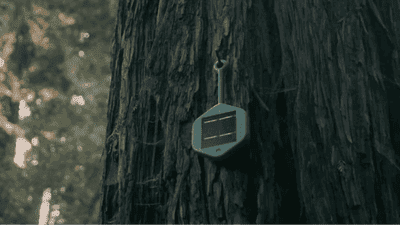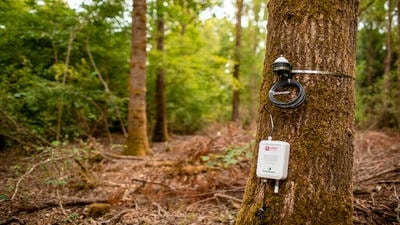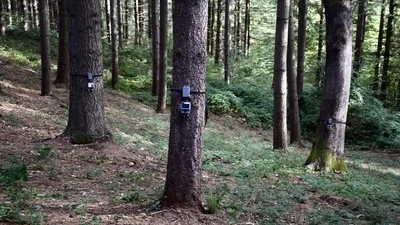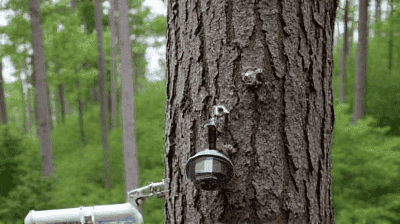
Forests are vital ecosystems that play a crucial role in maintaining planetary health. They provide habitat for countless species, sequester carbon dioxide, and contribute to the water cycle. However, forests around the world face numerous threats, including deforestation, climate change, and pollution, putting their health at risk. As the importance of preserving these natural resources grows, innovative technologies are emerging to help monitor and manage forest ecosystems more effectively. One such advancement is the concept of the “Internet of Trees,” which utilizes sensor networks to gather data on forest health.
The Internet of Trees refers to the integration of sensor networks in forest ecosystems to monitor various environmental parameters and collect real-time data. This concept is part of the broader Internet of Things (IoT), which connects various devices and systems to the internet for data exchange and analysis. In the context of forests, sensor networks can provide insights into tree health, soil conditions, climate variables, and biodiversity.
Sensors: The backbone of the Internet of Trees consists of various sensors that collect data. These sensors can monitor different parameters, such as temperature, humidity, soil moisture, light levels, and even the presence of pests or diseases.
Data Transmission: Collected data is transmitted to cloud-based platforms or researchers through wireless networks. This can be achieved using cellular networks, LoRaWAN, satellite connections, or other communication protocols designed for low-power devices.
Data Analytics: Once the data is collected and transmitted, it is analyzed using advanced algorithms and machine learning techniques. This analysis helps identify trends, detect anomalies, and generate actionable insights for forest management.
User Interfaces: Easy-to-use dashboards and mobile applications allow forest managers, researchers, and conservationists to access real-time data and visualize trends. These tools can enhance decision-making and improve response times to forest health issues.

Forests serve as critical ecosystems that support biodiversity, regulate climate, and provide numerous ecosystem services. Healthy forests contribute to:
Carbon Sequestration: Trees absorb carbon dioxide, helping mitigate climate change. Monitoring forest health enables the assessment of carbon stocks and the effectiveness of afforestation and reforestation initiatives.
Biodiversity Preservation: Forests are home to diverse plant and animal species. By monitoring habitats, conservationists can identify threats and implement measures to protect endangered species.
Soil and Water Conservation: Healthy forests regulate water cycles, prevent soil erosion, and protect watersheds. Monitoring soil moisture and water quality allows for better management of these critical resources.
Forests provide significant economic benefits through timber production, recreation, tourism, and non-timber forest products. By monitoring forest health, stakeholders can optimize resource management and ensure sustainable practices that safeguard livelihoods while protecting ecosystems.
Healthy forests contribute to human well-being by providing recreational opportunities, cultural significance, and aesthetic value. Monitoring enables communities to engage in forest management and conservation, fostering a sense of stewardship and connection to nature.
Several types of sensors are employed in the Internet of Trees to monitor various aspects of forest health:
Environmental Sensors: These sensors measure temperature, humidity, light intensity, and atmospheric pressure. They provide vital data about the climate conditions affecting forest ecosystems.
Soil Sensors: Soil moisture sensors monitor water content in the soil, while nutrient sensors assess soil fertility. Monitoring soil conditions is essential for understanding tree health and growth potential.
Biodiversity Sensors: Camera traps and acoustic sensors help monitor wildlife populations and biodiversity. These devices can track species presence, behaviors, and interactions within the ecosystem.
Health Monitoring Sensors: Sensors can detect signs of tree stress, such as dehydration, disease, or pest infestations. Tools like thermal imaging cameras or spectrometers analyze leaf temperatures and photosynthetic activity.
Effective data transmission is crucial for the Internet of Trees. Various communication protocols are used:
Low-Power Wide-Area Networks (LPWAN): Technologies like LoRaWAN and Sigfox are designed for low-power, long-range communication. They enable sensors to transmit data over vast distances while consuming minimal energy.
Cellular Networks: Mobile networks can be used for real-time data transmission in remote areas. While they require more power, they offer higher bandwidth for transmitting larger data sets.
Satellite Communication: In extremely remote or underserved areas, satellite communication provides a solution for data transmission, ensuring continuous monitoring even in challenging locations.
Once data is transmitted, it must be carefully processed and analyzed. Advanced analytics involves using machine learning algorithms and data visualization tools to identify patterns, trends, and anomalies in the collected data.
Machine Learning: Algorithms can analyze historical data to predict potential forest health issues, such as pest infestations, drought stress, or diseases.
Data Visualization: User-friendly dashboards and interactive maps allow stakeholders to visualize data effectively. These tools help translate complex datasets into actionable insights for forest management.

The Internet of Trees enables real-time monitoring of forest health, providing immediate insights into environmental conditions. By continuously tracking parameters such as temperature, humidity, and soil moisture, forest managers can quickly identify stress signals in trees and take preventive measures.
Sensor networks can help detect the early signs of pest infestations and diseases. By analyzing data from health monitoring sensors, forest managers can implement targeted interventions to prevent outbreaks and protect tree populations from damage.
With the increasing impact of climate change on forest ecosystems, understanding how tree species respond to changing conditions is crucial. The Internet of Trees allows for the assessment of climate impacts on growth patterns, carbon sequestration, and species resilience.
Effective resource management is essential for sustainable forestry practices. Sensor networks can assist in optimizing water usage, ensuring that irrigation efforts are directed where they are most needed, and preventing over-extraction of water resources.
Monitoring biodiversity is critical for ecosystem health. The Internet of Trees allows for the tracking of wildlife populations, identifying potential threats, and ensuring that habitats are preserved for diverse species.
Engaging local communities in forest management is essential for the success of conservation efforts. The Internet of Trees can provide educational opportunities, allowing communities to learn about the importance of forest health and participate in monitoring and restoration activities.
The ForestWatch initiative employs sensor networks to monitor forests in New Zealand. Using a combination of environmental and biodiversity sensors, the project collects real-time data on tree health, soil conditions, and wildlife populations. This information is used to assess the impact of climate change and inform conservation efforts.
In Finland, researchers have implemented the Smart Forest project, which integrates IoT technology to monitor forest dynamics. This initiative uses sensors to collect data on tree growth, carbon storage, and biodiversity. The data is analyzed to inform sustainable forest management practices and support biodiversity conservation.
This initiative, operating in regions like Southeast Asia, employs sensor networks to monitor tropical forests and adjacent agricultural landscapes. The collected data helps assess deforestation rates, land-use changes, and biodiversity loss, guiding conservation strategies that balance agriculture and forest preservation.
In the Amazon rainforest, researchers are utilizing sensor networks to monitor changes in biodiversity due to deforestation and climate pressures. The data collected enables timely interventions and promotes collaborative conservation efforts among local communities and conservation organizations.
Urban forests are vital for enhancing city environments and improving air quality. In cities like Los Angeles, sensor networks are deployed to monitor the health of urban trees, assess air quality, and evaluate the impact of urban heat islands. This data informs urban planning efforts that support green infrastructure.

The Internet of Trees provides stakeholders with accurate, real-time data, enabling informed decision-making. Forest managers can respond quickly to emerging threats and implement effective conservation strategies based on reliable data.
By continuously monitoring forest health, the Internet of Trees enhances ecosystem resilience. Proactive measures can be taken to address stress factors, ensuring that forests are better equipped to adapt to changing environmental conditions.
The data collected by sensor networks allows for the efficient management of forest resources. By understanding water usage patterns and soil conditions, forest managers can optimize irrigation and minimize resource wastage.
Using sensor networks reduces the costs associated with traditional forest monitoring methods. Continuous data collection and analysis minimize the need for extensive field surveys, resulting in cost savings for conservation organizations.
The Internet of Trees fosters collaboration among researchers, governments, NGOs, and local communities. Shared data and insights enhance cooperative efforts and lead to more coordinated and effective conservation strategies.
Establishing sensor networks requires significant initial investment in infrastructure and technology. Ensuring that the costs are justified by the benefits will be essential for widespread adoption.
As with any IoT application, concerns related to data privacy and security arise. Safeguarding sensitive ecological data against cyber threats is crucial to maintaining trust among stakeholders.
Implementing the Internet of Trees requires technical expertise in both environmental science and data analytics. Training programs may be necessary to equip local stakeholders with the skills needed to utilize the technology effectively.
Sensor deployment must be carefully planned to avoid disrupting sensitive habitats. Assessing potential environmental impacts is essential before installing sensor networks in forested areas.
In remote forest areas, establishing reliable internet connectivity for real-time data transmission poses challenges. Identifying suitable communication technologies and expanding network coverage will be crucial for successful implementation.
As sensor technology advances, improvements in miniaturization, power efficiency, and measurement capabilities will enhance the effectiveness of monitoring forest health. Emerging technologies like nanotechnology and bio-sensors may play key roles.
The use of drones equipped with advanced sensors can expand the capabilities of the Internet of Trees. Drones can cover larger areas quickly, monitor hard-to-reach locations, and collect high-resolution data, complementing ground-based sensor networks.
Integrating artificial intelligence and big data analytics into the Internet of Trees will enhance data processing and analysis. Predictive models can provide valuable insights into forest health, enabling timely interventions and proactive management.
The concept of the Internet of Trees has the potential to expand globally, with projects implemented in diverse forest ecosystems. As awareness grows about the importance of forest health, funding and collaboration opportunities will increase.
Supporting policies and regulations that encourage the implementation of IoT technologies in forest management will contribute to widespread adoption. Governments and international organizations can play a critical role in promoting the Internet of Trees.
The Internet of Trees offers an innovative approach to monitoring and managing forest ecosystems, combining cutting-edge technology with environmental stewardship. By integrating sensor networks to gather real-time data on forest health, we can take proactive measures to protect and restore these invaluable ecosystems.
As the challenges facing forests continue to escalate due to climate change and human activities, the need for effective monitoring solutions becomes increasingly urgent. Implementing the Internet of Trees has the potential to enhance decision-making, improve resource management, and foster collaboration among stakeholders, ultimately contributing to the preservation of forests for future generations.
By embracing the Internet of Trees, we can harness technology to safeguard our planet's forests, ensuring their health and vitality in the face of environmental challenges. With continued research, investment, and community engagement, this innovative approach to forest conservation can pave the way for a greener, more sustainable future.